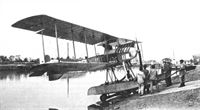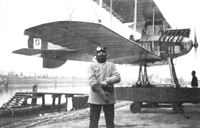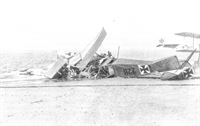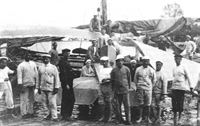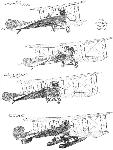
Описание
Страна: Германия
Год: 1913
Варианты
- Albatros - B.I - 1913 - Германия
- Albatros - WDD / W.1 - 1913 - Германия
- Albatros - B.II - 1914 - Германия
- Albatros - B.III - 1915 - Германия
- Лебедев - Лебедь-XI - 1915 - Россия
- Albatros - C.III - 1916 - Германия
- Albatros - C.IV - 1916 - Германия
- Albatros - C.VI - 1916 - Германия
- Albatros - W.2 - 1916 - Германия
- Лебедев - Лебедь-XII - 1916 - Россия
- Лебедев - ЛМ-1 / Лебедь Морской - 1916 - Россия
- O.Thetford, P.Gray German Aircraft of the First World War (Putnam)
- J.Herris Albatros Aircraft of WWI. Vol.3: Bombers, Seaplanes, J-types (A Centennial Perspective on Great War Airplanes 26)
- J.Davilla Italian Aviation in the First World War. Vol.2: Aircraft A-H (A Centennial Perspective on Great War Airplanes 74)
- Журнал Flight
-
J.Herris - Albatros Aircraft of WWI. Volume 3: Bombers, Seaplanes, J-types /Centennial Perspective/ (26)
This Albatros WDD competed in the 1913 Bodensee contest.
-
J.Herris - Albatros Aircraft of WWI. Volume 3: Bombers, Seaplanes, J-types /Centennial Perspective/ (26)
This Albatros WDD with 120 hp Mercedes and brow radiator with enlarged rudder and fixed fin..
-
J.Herris - Albatros Aircraft of WWI. Volume 3: Bombers, Seaplanes, J-types /Centennial Perspective/ (26)
Albatros WDD with yet another tail design and small national insignia on the fuselage. Side radiators have replaced the brow radiator used on earlier WDDs.
-
J.Herris - Albatros Aircraft of WWI. Volume 3: Bombers, Seaplanes, J-types /Centennial Perspective/ (26)
Albatros W.1 Marine Number 52. WWDs 52-56 were retroactively designated W.1s and their Marine Numbers given a '5' prefix to deceive Allied intelligence. Design of the tail surfaces and floats of the WDD/W.1 were in constant evolution.
-
J.Herris - Albatros Aircraft of WWI. Volume 3: Bombers, Seaplanes, J-types /Centennial Perspective/ (26)
Albatros W.1 Marine Number 55 assigned to the Kiel Naval Air Station.
-
M.Schmeelke - "Torpedo Los!" /Aeronaut/
Albatros W.1 Marine Number 55 assigned to the Kiel Naval Air Station.
-
J.Herris - Albatros Aircraft of WWI. Volume 3: Bombers, Seaplanes, J-types /Centennial Perspective/ (26)
Albatros W.1 Marine Number 74 assigned to the Kiel Naval Air Station.
-
J.Herris - Albatros Aircraft of WWI. Volume 3: Bombers, Seaplanes, J-types /Centennial Perspective/ (26)
Albatros W.1 Marine Number 226.
-
J.Herris - Albatros Aircraft of WWI. Volume 3: Bombers, Seaplanes, J-types /Centennial Perspective/ (26)
Albatros W.1 Marine Number 228.
-
J.Davilla - Italian Aviation in the First World War. Vol.2: Aircraft A-H /Centennial Perspective/ (74)
Albatros WDD '27', Venice, 1915
-
R.Gentilli - Italian Aviation Units in the First World War. Vol.4 /Aeronaut/ (4)
Albatros WDD #27, Stazione Idrovolanti Venezia, 1915
-
J.Herris - Albatros Aircraft of WWI. Volume 3: Bombers, Seaplanes, J-types /Centennial Perspective/ (26)
Side view of the Albatros WDD flown in the 1913 Bodensee Contest shows the rudder shape more clearly. (Peter M. Grosz Collection/SDTB)
-
J.Herris - Albatros Aircraft of WWI. Volume 1: Early Two-Seaters /Centennial Perspective/ (24)
The Albatros WDD was a floatplane derivative of the DD land plane and is shown here before the war. It had a Mercedes engine and 'brow' radiator.
-
J.Herris - Albatros Aircraft of WWI. Volume 3: Bombers, Seaplanes, J-types /Centennial Perspective/ (26)
The Albatros WDD that competed in the 1913 Bodensee Contest had a smaller rudder than later aircraft.
-
A.Imrie - German Naval Air Service /Arms & Armour/
Albatros GmbH of Johannisthal were awarded a five-aircraft order, their Avro version being powered by either the 100hp Argus or Mercedes six-cylinder water-cooled engine. Three machines were to be fitted with wireless receiving equipment, and the weight of this plus the necessary 6 metres high aerial mast seen here, had to be carried during the acceptance trials. The contract stipulated that the machine's performance had to equal that of the Avro and that the two aircraft without wireless equipment were to be fitted with dual flying controls.
-
A.Imrie - German Naval Air Service /Arms & Armour/
Albatros seaplane on the Muggelsee near Berlin. Training new pilots to fly seaplanes was undertaken at Putzig Naval Air Station in West Prussia from October 1914, but eventually the bulk of initial water flying was done in special training sections of the operational air stations, since it was found that it was easier for pupils to appreciate the practical requirements of front-line seaplane handling and thus convert more readily to the operational types of seaplane in a front-line air station environment.
-
J.Herris - Albatros Aircraft of WWI. Volume 3: Bombers, Seaplanes, J-types /Centennial Perspective/ (26)
Early Albatros WDD with brow radiator. (Peter M. Grosz Collection/SDTB)
-
J.Herris - Albatros Aircraft of WWI. Volume 3: Bombers, Seaplanes, J-types /Centennial Perspective/ (26)
Originally known as the Albatros WDD (for Wasser Doppeldecker Doppelsitzer, water biplane two-seater), the WDD and its modifications were retroactively designated Albatros W.1. The WDD first flew in the autumn of 1913.
-
J.Herris - Albatros Aircraft of WWI. Volume 3: Bombers, Seaplanes, J-types /Centennial Perspective/ (26)
This photo shows the next evolution of the Albatros WDD design with a revised rudder shape and larger tail float.
-
J.Herris - Albatros Aircraft of WWI. Volume 3: Bombers, Seaplanes, J-types /Centennial Perspective/ (26)
This photo shows the next evolution of the Albatros WDD design with a revised rudder shape and larger tail float. The seaplane below carries an early national insignia. (Peter M. Grosz Collection/SDTB)
-
J.Herris - Albatros Aircraft of WWI. Volume 3: Bombers, Seaplanes, J-types /Centennial Perspective/ (26)
This Albatros W.1 is seen just after take-off; it has no tail float but does have a leading edge radiator and carries national insignia and a naval pennant. (Peter M. Grosz Collection/SDTB)
-
J.Herris - Albatros Aircraft of WWI. Volume 3: Bombers, Seaplanes, J-types /Centennial Perspective/ (26)
Early Albatros WDD Marine Number 20. (Peter M. Grosz Collection/SDTB)
-
J.Herris - Albatros Aircraft of WWI. Volume 3: Bombers, Seaplanes, J-types /Centennial Perspective/ (26)
This Albatros WDD with enlarged tail surfaces and tail float retains the brow radiator. (Peter M. Grosz Collection/SDTB)
-
Журнал - Flight за 1914 г.
7. The New Albatros Tractor seaplane.
-
J.Herris - Albatros Aircraft of WWI. Volume 3: Bombers, Seaplanes, J-types /Centennial Perspective/ (26)
Closeup of an Albatros W.1. (Peter M. Grosz Collection/SDTB)
-
J.Herris - Albatros Aircraft of WWI. Volume 3: Bombers, Seaplanes, J-types /Centennial Perspective/ (26)
Later production Albatros WDD with side radiators and enlarged tail surfaces with horn-balanced rudder and tail float.
-
J.Herris - Albatros Aircraft of WWI. Volume 3: Bombers, Seaplanes, J-types /Centennial Perspective/ (26)
Albatros WDD with side radiators and enlarged tail surfaces and tail float but no horn balance on rudder.
-
J.Herris - Albatros Aircraft of WWI. Volume 3: Bombers, Seaplanes, J-types /Centennial Perspective/ (26)
Marine Number 552 is a confusing aircraft. MN552 is identified as a Brandenburg built by Danzig in the list of marine numbers but is actually Albatros W.1 Marine Number 52. The Marine Numbers of Albatros W.1/WDD 52-56 were apparently prefixed with a '5' when painted to confuse Allied intelligence. However that worked, it did serve to confuse the author for a time! The W.1 has a redesigned tail compared to the WDD; the rudder was enlarged and the tail float was eliminated.
-
J.Herris - Albatros Aircraft of WWI. Volume 3: Bombers, Seaplanes, J-types /Centennial Perspective/ (26)
Another view of Marine Number 552, identified as a Brandenburg built by Danzig in the list of marine numbers.
-
J.Herris - Albatros Aircraft of WWI. Volume 3: Bombers, Seaplanes, J-types /Centennial Perspective/ (26)
This appears to be a front view of W.1 Marine Number 552. It has 3-bays of struts, is in similar pose as the other two photos, and has the navy ID pennants. The gravity tank under the upper wing is also present in all photos.
-
M.Dusing - German Aviation Industry in WWI. Volume 1 /Centennial Perspective/ (84)
This seaplane is a mystery. According to the Navy Directory, this was a Brandenburg Type W.1 built at KW in Danzig. Other sources (J. Herris in [Albatros Aircraft of WWI, Vol. 3,]) refer to this seaplane as the Albatros W.1.
-
M.Dusing - German Aviation Industry in WWI. Volume 1 /Centennial Perspective/ (84)
Alb W.1 (WDD)(1916).
-
J.Herris - Albatros Aircraft of WWI. Volume 3: Bombers, Seaplanes, J-types /Centennial Perspective/ (26)
Albatros W.1 Marine Number 55 was assigned to the Kiel naval air station. It has side radiators and tail float and the main floats are of revised design. The wings have been roughly cropped; likely as a result of a forced landing at sea with the crew chopping off the outer wings to make the aircraft more stable on the water while awaiting rescue. (Peter M. Grosz Collection/SDTB)
-
J.Herris - Albatros Aircraft of WWI. Volume 3: Bombers, Seaplanes, J-types /Centennial Perspective/ (26)
Albatros W.1 Marine Number 74 was assigned to the Kiel naval air station. It has side radiators and tail float although the main floats are of revised design. It carries 1918 national insignia on its rudder and a naval pennant. (Peter M. Grosz Collection/SDTB)
-
J.Herris - Albatros Aircraft of WWI. Volume 3: Bombers, Seaplanes, J-types /Centennial Perspective/ (26)
Albatros W.1 Marine Number 74 was assigned to the Kiel naval air station. It has side radiators and tail float and the main floats are of original design. It carries 1918 national insignia on its rudder and naval pennants. The engine exhaust manifolds and float design differ from those shown on the facing page on this same aircraft. (Peter M. Grosz Collection/SDTB)
-
J.Herris - Albatros Aircraft of WWI. Volume 3: Bombers, Seaplanes, J-types /Centennial Perspective/ (26)
This Albatros W.1 in its hangar has a later design of enlarged vertical tail surfaces without tail float. (Peter M. Bowers Collection/Museum of Flight)
-
J.Herris - Albatros Aircraft of WWI. Volume 3: Bombers, Seaplanes, J-types /Centennial Perspective/ (26)
Albatros W.1 Marine Number 228 illustrate the final configuration of the Albatros W.1 with enlarged tail surfaces and no tail float. (Peter M. Grosz Collection/SDTB)
-
K.Delve - World War One in the Air /Crowood/
Albatros Type В at Wilhelmshafen in service with II. Seeflieger Abteilung, probably 1915. The German seaplanes were aggressively operated over the North Sea and carried out a wide range of roles, frequently in conjunction with either submarine or surface vessel operations.
-
J.Herris - Albatros Aircraft of WWI. Volume 3: Bombers, Seaplanes, J-types /Centennial Perspective/ (26)
Albatros W.1 Marine Number 229 illustrate the final configuration of the Albatros W.1 with enlarged tail surfaces and no tail float. (Peter M. Grosz Collection/SDTB)
-
J.Herris - Albatros Aircraft of WWI. Volume 3: Bombers, Seaplanes, J-types /Centennial Perspective/ (26)
Albatros W.1 Marine Number 229 being brought ashore after a flight. (Peter M. Grosz Collection/SDTB)
-
J.Herris - Albatros Aircraft of WWI. Volume 3: Bombers, Seaplanes, J-types /Centennial Perspective/ (26)
Albatros W.1 Marine Number 230 afloat before a flight. (Peter M. Grosz Collection/SDTB)
-
J.Herris - Albatros Aircraft of WWI. Volume 3: Bombers, Seaplanes, J-types /Centennial Perspective/ (26)
Late production Albatros W.1 taking off.
-
J.Herris - Albatros Aircraft of WWI. Volume 3: Bombers, Seaplanes, J-types /Centennial Perspective/ (26)
Late production Albatros W.1 ready for take-off. (Peter M. Bowers Collection/Museum of Flight)
-
A.Imrie - German Naval Air Service /Arms & Armour/
Mobilization seaplanes on the ramp at Kiel-Holtenau in August 1914. Aircraft identified in this early wartime photograph include: Rumpler 4B11 (150hp Benz) from Warnemunde, Sopwith Bat-Boat 44 (which was never used operationally but merely for short local flights), Friedrichshafen FF19 23 and Albatros B I on floats, which was another machine taken over on the outbreak of war at Warnemunde. All aircraft are carrying red streamers from the bottom wings near the tips for identification purposes and are marked with the Iron Cross type of national insignia.
Другие самолёты на фотографии: Friedrichshafen FF19 - Германия - 1914Rumpler 4B - Германия - 1914Sopwith Bat Boat - Великобритания - 1913
-
R.Gentilli - Italian Aviation Units in the First World War. Vol.4 /Aeronaut/ (4)
At Porto Corsini, in 1915, a Breguet floatplane while an Albatros W is taxiing in the canal.
Другие самолёты на фотографии: Breguet 3 - Франция - 1910
-
R.Gentilli - Italian Aviation Units in the First World War. Vol.4 /Aeronaut/ (4)
Albatros 27 at Venice. These floatplanes were poorly armed, but they were reliable and long-lived.
-
R.Gentilli - Italian Aviation Units in the First World War. Vol.4 /Aeronaut/ (4)
An Albatros floatplane with pilot STV Montanarella.
-
R.Gentilli - Italian Aviation Units in the First World War. Vol.4 /Aeronaut/ (4)
An FBA Type C of the French Navy in Venice. Behind it is Albatros 31.
Другие самолёты на фотографии: FBA Type A/B/C - Франция - 1913
-
M.Schmeelke - "Torpedo Los!" /Aeronaut/
SFS Kiel-Holtenau also provided Albatros WDD (55) for Torpedoflieger training. It was written off on 16 December 1916 after an accident. Here it is seen after a forced landing, which may be the accident that caused it to be written off.
Despite the inscription on this contemporary postcard and the use of a Rumpler rudder, 'Kiel 55' was an early Albatros seaplane, and is shown being towed after retrieval in the Baltic. The crew have carried out the laid-down survival drill well. They have chopped off the outer wing panels to prevent them becoming waterlogged, thus reducing the risk of capsizing; and to 'lighten ship', heavy components from the engine have been detached and dumped overboard. This procedure enabled twin-float seaplanes to remain afloat for long periods in sea conditions well in excess of their seaworthiness rating. Many crews were saved as a result. -
M.Schmeelke - "Torpedo Los!" /Aeronaut/
Albatros W.1 Marine Number 55 was assigned to the Kiel naval air station. It has side radiators and tail float and the main floats are of revised design. The wings have been roughly cropped; likely as a result of a forced landing at sea with the crew chopping off the outer wings to make the aircraft more stable on the water while awaiting rescue. (Peter M. Grosz Collection/SDTB)
-
J.Herris - Albatros Aircraft of WWI. Volume 3: Bombers, Seaplanes, J-types /Centennial Perspective/ (26)
Albatros W.1 Marine Number 223 being hoisted out of the water after an accident. (Peter M. Grosz Collection/SDTB)
-
J.Herris - Albatros Aircraft of WWI. Volume 3: Bombers, Seaplanes, J-types /Centennial Perspective/ (26)
Albatros W.1 Marine Number 226 appears to be a total loss. Marine Number 512 in the background is a Brandenburg FB. (Peter M. Grosz Collection/SDTB)
Другие самолёты на фотографии: Hansa-Brandenburg NW / GNW - Германия - 1915
-
R.Gentilli - Italian Aviation Units in the First World War. Vol.4 /Aeronaut/ (4)
A damaged Albatros W, in its rudder the shield of Savoy with the royal crown appears.
-
Журнал - Flight за 1915 г.
FUSELAGE ECONOMY. - Four members of the Albatros family, all of which are fitted with the same size fuselage. In this manner three different types of land machines can be provided simply by substituting wings of various sizes, whilst the larger size machine is turned into a seaplane by fitting floats instead of the usual undercarriage.
Другие самолёты на фотографии: Albatros B.I - Германия - 1913Albatros B.II - Германия - 1914Albatros racing biplane - Германия - 1913
O.Thetford, P.Gray German Aircraft of the First World War (Putnam)
Albatros W 1
Powered with 150 h.p. Benz III, the W I was basically an unarmed reconnaissance seaplane version of the three-bay Albatros B II land machine.
Описание:



















































